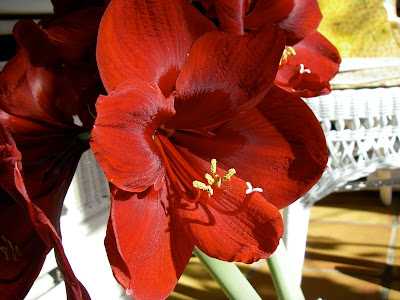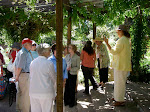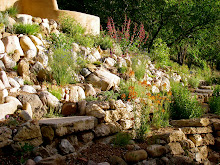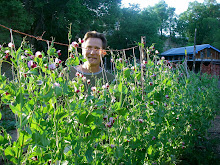
A good compost pile is the backbone of a good garden. I like to have a hot compost, above 140 degrees Farenheit, preferably. The hot temperature is the result of microbes digesting the organic matter in the pile. Hot compost kills weed seeds and pathogens. However, some people prefer cold compost, which is easier to make, but takes longer. Anytime you put together a large pile of organic matter and water it will eventually decay. Don't feel daunted if you can't put up a Cadillac Compost Bin like we have. Just a pile will work, as long as it is big enough. Compost happens!

We used to just have a compost pile, which worked but was messy, especially after some of the community dogs developed a taste for rotted kitchen scraps. So the community agreed to invest in some really fine bins. I based the design on the ones we had been using at LQ, which Alec, the compost king, had built. But these bins are even better. There are four bins, each four feet wide and six feet deep by five feet high. The front is made of 1" X 10"s which slide into place between grooves. Between the bins there's a similar system in the front half of the dividing separation. The back half and the outside are reinforced wire mesh.

My husband Steve, the reigning regent of the veggie garden at TP, has taken on the composting duties as well. He likes seeing the magical transformation of waste into black gold. Finished compost is black and crumbly, with no smell. It is essential for organic gardening.

There are four bins in all. We use the left bin, Bin A, to accumulate chopped organic material. Kitchen scraps not fed to the goats and chickens, like onions, coffee grounds, and citrus peels go into the small tin trash can so he can properly integrate them into the pile. Bin B is the newest pile, made from a mixture of the goat and chicken pen mucked out material, the chopped weeds and prunings from bin A, and kitchen scraps all. These materials are layered like lasagna, watered as they go in. The whole pile is topped with a layer of straw or dry leaves.

The compost gets turned twice a year. It's a big job and does take some muscle. Definitely better with a few folks taking turns...that's one of the advantages of cohousing. Before the biannual mucking, we turn the piles to empty Bin B so it's ready to receive the new compost. Bin D, on the far right, is the oldest, and has been emptied by then. So the pile in C goes into D, then B is turned into C, leaving B empty for the new pile. The compost goes mostly to the veggie garden, which is close at hand. Some makes its way to the ornamental gardens as well, adding valuable nitrogen and organic matter to our sandy soil.

Here Steve turns the pile from one bin to the next. You can see how useful the removable slats between the bins are. The turning speeds up the process, as material that had been squashed on the bottom winds up on the top, and everything is mixed up, making material more accessible to the tiny organisms that are working on it.

I often liken building a compost pile to making bread. Both depend on biological activity to work, and require a familiarity with getting the right balance of ingredients. As Steve turns the material, he fluffs it with a practiced toss of the pitch fork. This adds air into the pile, which is necessary for biological activity. Meanwhile I add water with a hose. I use a brass shut-off valve to control the spray and am careful not to overwater, which would cause the pile to go anaerobic. It should feel like a damp sponge. Without any water, there would be no decomposition.

Because our manure comes from the goat pen, it is often trampled into hard layers. Here he breaks up the clods with a Japanese farmer's hoe, which we got from Seeds of Change. "Get the right tool for the job!" sez Mr. Natural.

On one of our Community Days, we see another cohousing resident cutting sunflower stalks into short lengths before they are put into the bin. This is an important step; chopped material breaks down much more quickly, and doesn't cause problems when turning the pile.

The finished product enriches the veggie garden in the early spring before planting. We love our compost bins; now we have a neat pile and no more sick dogs! The soil here is very low in organic matter and the sunlight is so intense that it burns it up quickly. If we didn't make compost we'd have to buy it to be able to do a vegetable garden. But since we have the animals and lots of organic waste at hand, it makes sense to nourish the land, and ultimately ourselves, this way.
 Set in a pool of sunshine in our kitchen in deep winter, one Amaryllis bulb provided this glorious sight.
Set in a pool of sunshine in our kitchen in deep winter, one Amaryllis bulb provided this glorious sight. In order to keep your bulbs blooming each year, it is important to think of them as a crop, rather like an onion. After all frost danger in the spring, take the bulbs out of their pot and replant them in a well-prepared garden bed with ample sun, water, and nutrients. Allow them to grow there until just before the first frost in the fall. Then repot them (they may need slightly larger pots) in well-drained potting soil and bring inside. Remove only damaged leaves; do not take off all the foliage. With this treatment you can have flowers every year from the same bulb, which makes the rather hefty price tag ($8 to$20 each) a little more tolerable!
In order to keep your bulbs blooming each year, it is important to think of them as a crop, rather like an onion. After all frost danger in the spring, take the bulbs out of their pot and replant them in a well-prepared garden bed with ample sun, water, and nutrients. Allow them to grow there until just before the first frost in the fall. Then repot them (they may need slightly larger pots) in well-drained potting soil and bring inside. Remove only damaged leaves; do not take off all the foliage. With this treatment you can have flowers every year from the same bulb, which makes the rather hefty price tag ($8 to$20 each) a little more tolerable! These African flowers have been greatly altered by many years of selection, particularly by Dutch plant breeders. They come in a range of colors, from white, pale pink, apricot, coral, orange, scarlet, red, burgundy, to almost black. Lovely blends, stripes, and picotee markings have been achieved, and some have a green throat, which I especially like. Some are quite tall, and with their top-heavy blossoms may require staking. Much shorter varieties are also available, which may be more practical. To me these look a bit out of proportion.
These African flowers have been greatly altered by many years of selection, particularly by Dutch plant breeders. They come in a range of colors, from white, pale pink, apricot, coral, orange, scarlet, red, burgundy, to almost black. Lovely blends, stripes, and picotee markings have been achieved, and some have a green throat, which I especially like. Some are quite tall, and with their top-heavy blossoms may require staking. Much shorter varieties are also available, which may be more practical. To me these look a bit out of proportion. Fancy double flowers with ornately recurving petals and delicate coloration are the ultimate in amaryllis beauty. I love the sculptural quality of the huge petals. I have also been amazed by the iridescent rainbow sheen on the petals in the sunlight seen only with close examination. These are almost magically enlarged flowers, making me think of Georgia O'Keefe and Alice in Wonderland. How could you not love them?
Fancy double flowers with ornately recurving petals and delicate coloration are the ultimate in amaryllis beauty. I love the sculptural quality of the huge petals. I have also been amazed by the iridescent rainbow sheen on the petals in the sunlight seen only with close examination. These are almost magically enlarged flowers, making me think of Georgia O'Keefe and Alice in Wonderland. How could you not love them? In winter when the gardens in Santa Fe lie dormant, we keep 20 or more amaryllis bulbs in separate pots in a sunny laundry room for Mrs. B's delight. Each year it seems she can't resist getting one or two more. As the buds begin to emerge we bring them into her sunroom, where they are placed to good advantage.
In winter when the gardens in Santa Fe lie dormant, we keep 20 or more amaryllis bulbs in separate pots in a sunny laundry room for Mrs. B's delight. Each year it seems she can't resist getting one or two more. As the buds begin to emerge we bring them into her sunroom, where they are placed to good advantage. With the grande dame amaryllis blooms interspersed among other winter flowering plants, such as hibiscus, jasmine, and bougainvillea, the sunroom becomes a glorious jungle! Some of the plants are deliberately chosen for fragrance, which makes up for the showier blossoms' lack of scent.
With the grande dame amaryllis blooms interspersed among other winter flowering plants, such as hibiscus, jasmine, and bougainvillea, the sunroom becomes a glorious jungle! Some of the plants are deliberately chosen for fragrance, which makes up for the showier blossoms' lack of scent.  As you can see from the bouquet of freshly picked daffodils, this photo was taken in April. The Amaryllis collection at LQ comes into bloom over a five or six month period, which means that one or two bulbs will be in bloom at any given time throughout the cold months. Note the stakes on these long-stemmed flowers, as well as the abundant foliage, which I feel adds to their appeal. So this season adopt an amaryllis, give it a good home with year-round love, and it will return that love with a gift of beauty that will brighten your winters for many years to come!
As you can see from the bouquet of freshly picked daffodils, this photo was taken in April. The Amaryllis collection at LQ comes into bloom over a five or six month period, which means that one or two bulbs will be in bloom at any given time throughout the cold months. Note the stakes on these long-stemmed flowers, as well as the abundant foliage, which I feel adds to their appeal. So this season adopt an amaryllis, give it a good home with year-round love, and it will return that love with a gift of beauty that will brighten your winters for many years to come!






 Santa Fe is high and sunny, which makes for a pleasant four season environment, but causes problems for fruit trees. The intense sunlight can trick the trees into blooming much too early. Then a cold snap or snow is bound to come along and kill the poor innocent little blossoms, leaving us with no fruit! This picture was taken on April 2, and the apricot , always adventurous, is already starting to burst into bloom.
Santa Fe is high and sunny, which makes for a pleasant four season environment, but causes problems for fruit trees. The intense sunlight can trick the trees into blooming much too early. Then a cold snap or snow is bound to come along and kill the poor innocent little blossoms, leaving us with no fruit! This picture was taken on April 2, and the apricot , always adventurous, is already starting to burst into bloom.











































